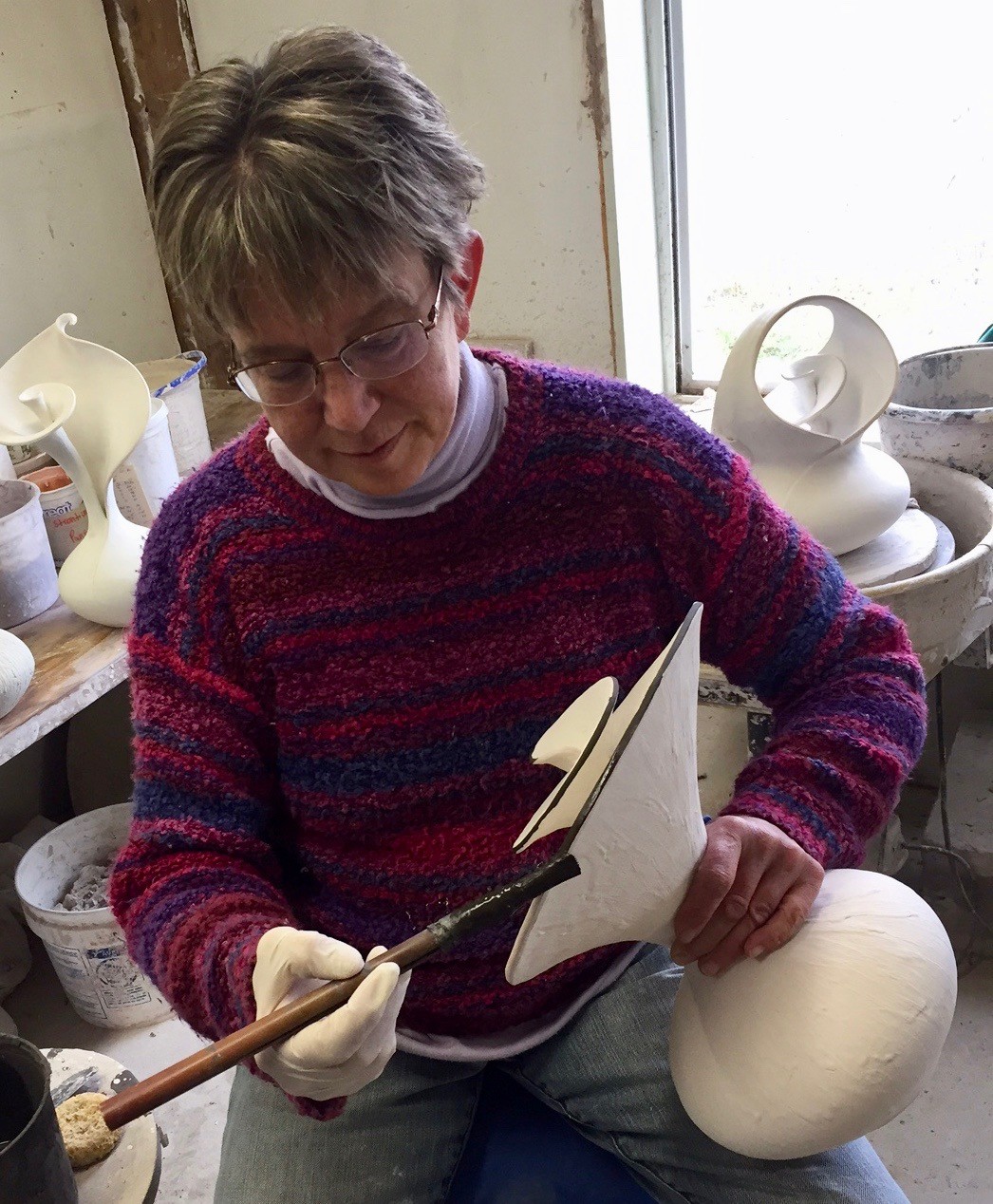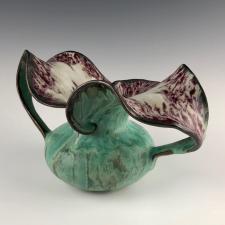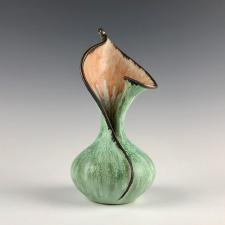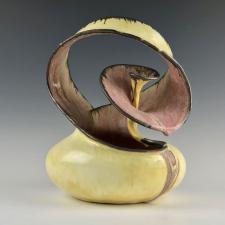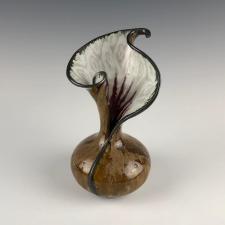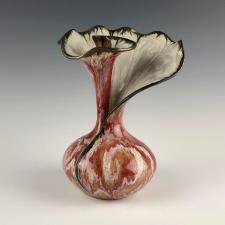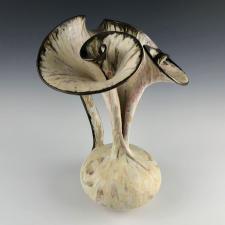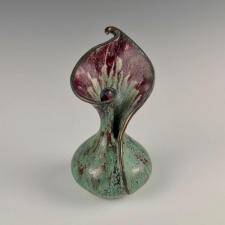Part II: Inspiration
Steve Basile, Curated Ceramics: Twenty years ago, you were doing functional work. At what point did you begin to see the seed of inspiration that is your work now? To your credit, you have a unique individual voice. That takes work. A lot of work. How did your signature design come into being?
Susan Anderson: Becoming a mom changed all my priorities as a potter. The minute I was pregnant was like, “this is great and nothing else matters.” This beautiful thing was happening in me and being a mom made me want to model honesty. I wanted pottery to be something more than a job. It made me want to dig down and find more meaning in the process than I had found in production pottery.
Through out my career I had been practicing hand building. While on maternity leave I was making a large hand built vase when the neck cracked. I got the idea that by wetting the torn edges I could build on to create a spiral imitating a worn sea shell.
When our second child was young, I had significant problems with my back at that point. So I started hand-building and playing with the idea of a swirl in a pot.
Curated: That’s now a signature mark of your work. The swirling or curling rim.
Susan: The swirl is what allows me to structurally make these forms. It provides the strength and allows for movement. It’s both beautiful and structural.
When you’re making traditional pots, you learn the aesthetic of proportion and how each curve relates. Like in a pitcher. You’ve got the belly, shoulder, neck, and opening. The balance and flow of those lines is very important to get just right. To make that wonderful pot you want to hold.
So in my work I’m now basing everything off of a spherical water jug shape. The belly and everything else that flows from that. Ideally each curve, negative and positive, is reflected proportionally within the piece. So that there is flow of mass, negative space, which is accentuated by line.
You start on the wheel and create a bowl form. You bring that inward then stop as it begins to form the base of a vase. Then you begin building the pot upward using pinch techniques.
Curated: What you’re saying is the whole rest of the pot is defined by what begins on the wheel.
Susan: Right. What will happen above has already been determined by what’s below.
Curated: That’s pretty amazing because I don’t think anyone would look at the belly of your pots and imagine the rest of this. I could see how the bottom would inform how the rest of the shape happens. But at what point do you begin visualizing the finished piece?
Susan: Actually, I make the base for the top because if it’s too light then the piece becomes top heavy.
One of the concepts I’m working with above the base is asymmetrical balance as a means of transformation in nature. How matter moves. How shells grow. How plants open. When you look at a hosta it goes through a period of time when it’s not symmetric because it’s still closed.
Curated: Asymmetry does not also mean unbalanced.
Susan: Right! It’s asymmetrical balance.
Curated: How do you envision these forms?
Susan: My creative process happens when I stop thinking. I have all these building ideas of asymmetrical balance. Pushing the limits of my work to stand up on a small base. How do I build that? How do I construct it? And then I’ll stand back and look at the relationship. The curves. Have I achieved the rhythm that I want in the profile?
Curated: This is interesting because we’re into something really profound. We’re at an understanding of who you are. You never stop thinking about process. Process leads to creative voice or vice versa?
Susan: Yes, process leads.
Curated: What you’re saying is that by using process that mimics nature, you arrive at this work.
Susan: Right. Instead of just taking my cues from tradition of pottery, I’m going back further to inspiration from the laws of nature.
Curated: As with the gravity, if the piece is physically balanced then it will also appear balanced to the eye. Gravity is an absolute in nature.
Susan: Spirals and their Fibonacci numbers are because of gravity. This begs the question of what might something grow like with a different gravity?
Curated: Or even a different gravitational force with two moons or two suns.
Susan: Yeah! How would that change the appearance of plants.
Curated: How would life look different under a different environment? This explains why you call it a “spiral” pot.
When I look at your work, my interpretation is you are inspired by flora. To some extent that’s true because flora is nature. But your work is even more fundamentally considered than that. You’re constructing pots to the laws of nature no different than a plant would grow to the laws of nature. So nature and gravity informs the physics you’re choosing with curves and spirals.
Susan: And the sphere form. My bases are spheres.
Curated: So your designs are spheres, curves, and spirals. Wow. Do most people know this about your work?
Susan: No. I come up with little catchphrases.
Curated: So your customers don’t shake their head and say, “This lady’s kind of spacey. She’s talking about gravity and her pots.”
Susan: (laughs) I’m indeed talking about gravity.
Curated: When we visited Wisconsin last year you had your pots on steps. I thought they looked flora inspired. That’s not the case. Your work is inspired by Fibonacci and gravity the same as flora is. That’s quite an epiphany for me.
I wonder how many of your collectors are inspired by flora and see science in your work?
Susan: Quite a few people. Scientists do. They say, “You’re all about the Fibonacci numbers. You’re all about the Golden Mean in Da Vinci’s work.”
Even our bodies follow these laws. Every human body is different. Long waisted, short waisted. Our bodies follow the rules of nature and end up balanced. Different proportions, totally unique, and balanced.
Curated: So when we react to something that’s balanced it has a calming influence. Unbalanced would then be upsetting or irritating.
Susan: I think so. Or unbalanced could be thought provoking.
I try to give my pieces each a personality. What does it look like to have a quiet leaf form? What does it look like when some wind is blowing and it’s moving all over the place. Trying to get that movement but maintain the balance of each curve to another.
I’ve watched a slow-motion video of a tulip growing and it went the same as a pot. Curve and recurve until it’s filled out.
Curated: Someone is going to google “pottery” and “Fibonacci” and they’re going to find you. They’ll look up pottery, science, and nature and they’re going to find you. Some will find you visually and some will find intellectually. I’m excited we were able to capture your thoughts on inspiration in this way.
©Curated Ceramics 2018. All text and images may not be reused without expressed permission from this website.
